Use of Observing Time
The available observing time on the ING telescopes is allocated between British,
Dutch and Spanish time allocation committees, the CCI International Time Programmes
(ITP), service and discretionary nights, and scheduled stand-down and commissioning
time.
The ING Board has delegated the task of time allocation to British astronomers
to the PPARC Panel for the Allocation of Telescope Time (PATT), and to Dutch
astronomers to the NFRA Programme Committee (PC). It is the responsibility
of the Instituto de Astrofísica de Canarias (IAC) to allocate the Spanish
time via the Comité para la Asignación de Tiempos (CAT). For
committee membership see Appendix I.
The aim of the ING service observing programme is to provide astronomers with
a way to obtain small sets of observations, which would not justify a whole
night or more of telescope time. On the WHT several nights per semester are
set-aside especially for this purpose. During those nights, ING support astronomers
perform observations for several service requests.
Stand-down and discretionary nights are used for major maintenance activities,
commissioning of new instruments, enhancements, calibration and quality control
tests, etc., and partly for astronomy, for example, as compensation for breakdowns
or for observations of targets of opportunity.
The way the available observing time on the ING telescopes has been shared
in 2004 and 2005 is summarised in Table 1.
| |
WHT |
INT |
| Time allocation |
2004 |
2005 |
2004 |
2005 |
| UK PATT |
139 |
130 |
174 |
163 |
| NL PC |
49 |
56 |
61 |
63 |
| SP CAT |
77 |
78 |
104 |
100 |
| ITP |
8 |
14 |
8 |
14 |
| TNG time share |
10 |
11 |
— |
— |
| Service |
19.5 |
17 |
— |
— |
| Instrument Builder’s Guaranteed Time |
17 |
19 |
0 |
0 |
| Stand-down and discretionary (including commissioning) |
46.5 |
40 |
19 |
25 |
|
| Total |
366 |
365 |
366 |
365 |
| |
Table 1. Number of nights allocated from Semester 2004A to 2005B. Service include UK and NL service time, and SP CAT includes Spanish service time. |
Use of Instrumentation
Figure 44 shows the allocation of nights per instrument on the WHT in 2004 and
2005. As in previous years, the ISIS spectrograph was the most popular instrument,
taking up some 40% of the scheduled observing time. Visiting instruments on
the WHT during this period include the SAURON integral field spectrograph, the
planetary nebula spectrograph, PN.S, the high-speed multi-CCD camera ULTRACAM,
the near-IR multi-object spectrograph, CIRPASS, and the PLANETPOL photo-polarimeter.
The INTEGRAL coherent fibre feed to the WYFFOS spectrograph is effectively operated
as a private instrument as well. In particular the ULTRACAM and PLANETPOL instruments
enjoyed much interest.
On the INT, dark time periods were exclusively used for CCD imaging with the
Wide Field Camera, as the INT was solely dedicated to wide field imaging programmes.
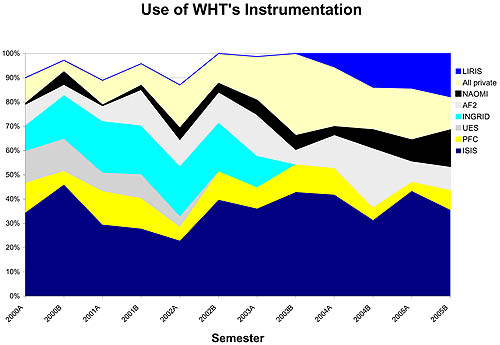 |
Figure 44. Use of WHT's instrumentation per semester
[ JPEG | TIFF ]. |
Telescope Reliability
During the year 2004 and 2005 the ING telescopes again performed very well,
with downtime figures due to technical problems averaging at 3.4% and 1.5%
in 2004 and 1.5% and 1.4% in 2005 for the WHT and the INT respectively. These
figures meet the target value of a maximum of 5% technical downtime. Down
time due to poor weather averaged 35% in 2004 and 34% in 2005. The historical
trends of technical down time and weather down time are plotted in Figures
45 and 46. Figure 47 shows the seasonal average.
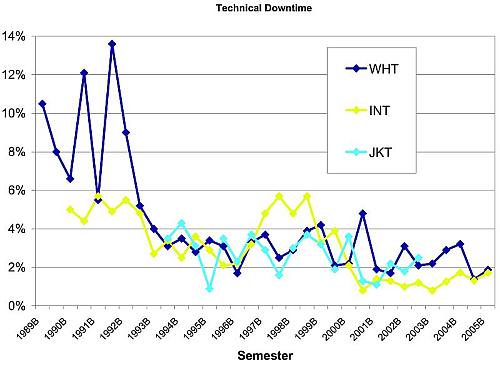 |
Figure 45. Technical downtime per semester [ JPEG
| TIFF ]. |
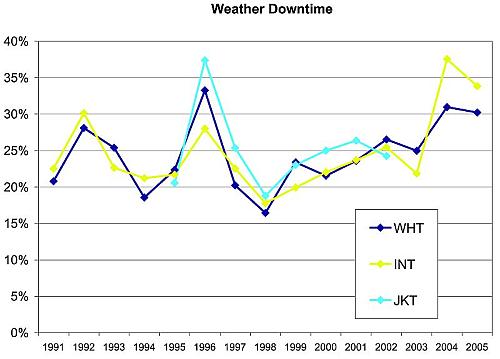 |
Figure 46. Weather downtime per year [ JPEG
| TIFF ]. |
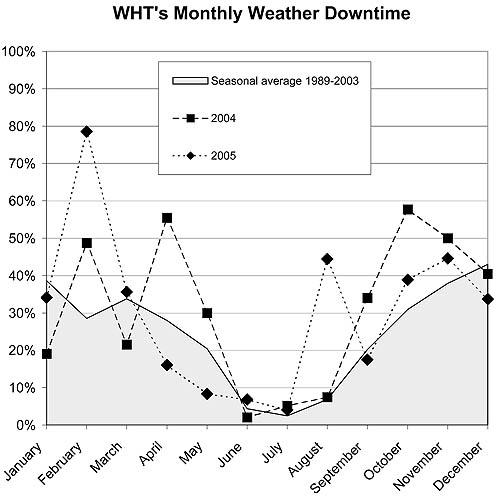 |
Figure 47. WHT’s monthly weather downtime
[ JPEG | TIFF ].
|
Scientific productivity
An important metric of the success of the ING telescopes is the number of publications
published in refereed journals and for this reason the ING Bibliography (see
Appendix E) is updated annually. Traditionally, this
bibliography has been compiled by visually scanning all articles in many journals
and identifying those which make use of data from our telescopes. However most
journals are now published electronically and often have quite sophisticated
search engines associated with them and it is therefore appropriate to conduct
the search with the help of these facilities.
Our selection process identifies papers that make direct use of observations
obtained with the ING telescopes, in order to qualify. Papers that refer to
data presented in earlier papers (derivative papers) are not counted.
When we analyse ING publications for the five years between 1995 and 1999 inclusive
it can be seen that more than 95% of articles are published in a small number
of core journals. These core journals consist of the British journal
MNRAS,
the American journals
Astrophys J,
Astrophys J Letters,
Astrophys
J Suppl,
Astron J and
PASP, plus the European journal
Astron Astrophys (including the now defunct
A&AS). We
also include
Nature and
Science as core journals due to their
perceived high impact. Journals making up the remainder of publications are
widely spread among such journals as Icarus and the
Irish Astronomical Journal
to name a few. The bibliography for the years 2004 and 2005 was compiled from
only the core journals listed above for reasons of efficiency. Search engines
were used to select papers and the resulting list of papers visually inspected
to ensure that they satisfied the selection criteria described above.
An analysis of these numbers follows (see Figures 48 to 52 and Table 2). Note
that if a paper makes use of more than one telescope we count that paper for
each telescope. Also, concerning perceived nationality we use the nationality
of the first author's institution although in a few cases two institutions are
credited. Similarly, if a paper makes use of more than one instrument, that
paper is counted against each instrument.
 |
Figure 48. Number of refereed papers per telescope
from first light year [ JPEG | TIFF
]. |
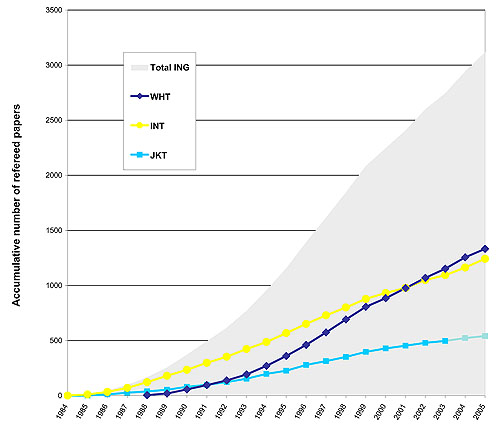 |
Figure 49. Accumulative number of refereed papers
per year [ JPEG | TIFF
]. |
| Year |
WHT |
INT |
JKT |
Total |
| 1984 |
— |
1 |
— |
1 |
| 1985 |
— |
10 |
3 |
13 |
| 1986 |
— |
24 |
8 |
32 |
| 1987 |
— |
36 |
16 |
52 |
| 1988 |
5 |
52 |
12 |
69 |
| 1989 |
15 |
58 |
15 |
88 |
| 1990 |
37 |
54 |
26 |
117 |
| 1991 |
39 |
63 |
19 |
121 |
| 1992 |
42 |
56 |
25 |
123 |
| 1993 |
55 |
70 |
30 |
155 |
| 1994 |
78 |
63 |
44 |
185 |
| 1995 |
90 |
81 |
29 |
200 |
| 1996 |
100 |
84 |
52 |
236 |
| 1997 |
113 |
77 |
35 |
225 |
| 1998 |
118 |
72 |
38 |
228 |
| 1999 |
115 |
78 |
46 |
239 |
| 2000 |
78 |
53 |
31 |
162 |
| 2001 |
91 |
46 |
25 |
162 |
| 2002 |
93 |
72 |
26 |
191 |
| 2003 |
82 |
44 |
17 |
143 |
| 2004 |
103 |
69 |
26 |
198 |
| 2005 |
77 |
80 |
18 |
175 |
|
| Total |
1333 |
1243 |
541 |
2743 |
| |
Table 2. Number of refereed papers per year and telescope. |
Of all the available instruments on the WHT, the ISIS spectrograph remains
the most productive instrument, with 42% of all publications during the reporting
period. The number of papers from visitor instruments on the WHT also remained
significant, with 16 papers over two years.
On the INT the papers are split very evenly between IDS spectrograph and the
Wide Field Camera as might be expected from the split of observing time between
these instruments, roughly 50-50.
Concerning the nationality of the first author's institution, there is little
change, at least considering the fluctuations from year to year. The UK share
is steady around 40%, and the Spanish share about 20%. The NL share also showed
little systematic change. Interestingly, about one third of the papers have
a first author from other countries, emphasizing the international character
of the observatory and the high level of international collaboration between
research groups.
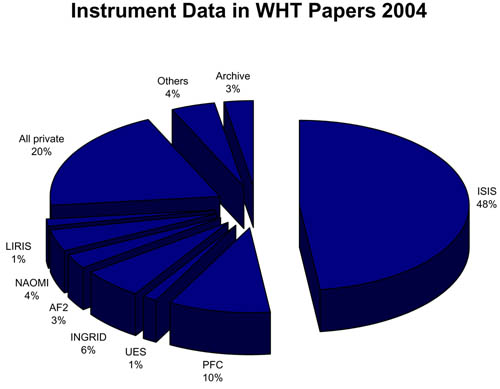 |
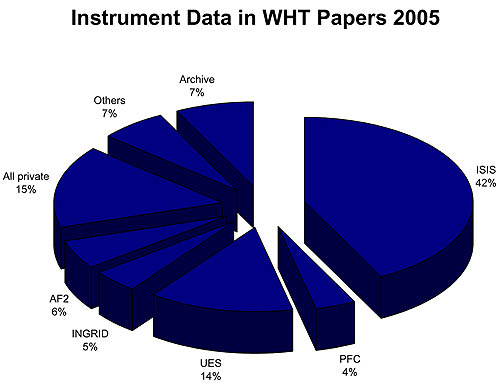 |
Figure 50. Top: Use of instrument data in WHT refeered
papers in 2004. Archival papers made use of data from ISIS, PFIP,
UES, INGRID and AUX [ JPEG | TIFF
]. Bottom: The same in 2005. A total of 12 papers resulted from
data obtained on service nights in both years [ JPEG
| TIFF ]. |
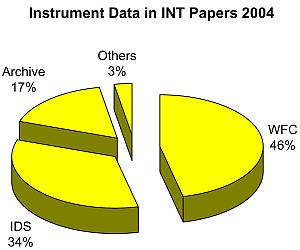 |
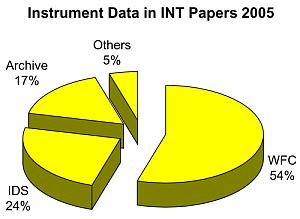 |
Figure 51. Top: Use of instrument data in INT refeered
papers in 2004. Archival papers made use of data from the PFIP, WFC
and IDS [ JPEG | TIFF
]. Bottom: The same in 2005. A total of 6 papers resulted
from data obtained on service nights in both years . [ JPEG
| TIFF ]. |
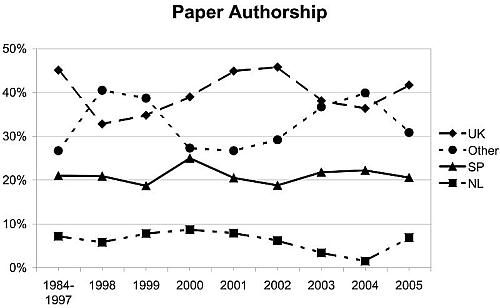 |
Figure 52. Evolution of the nationality of first
author’s first institution in ING refeered papers [ JPEG
| TIFF ]. |
The ING archive
All data taken with the ING telescopes is archived in the UK, at the Institute
of Astronomy, Cambridge. The data archive is managed by the Cambridge Astronomy
Survey Unit.
Archival data from the ING telescopes is made available to anyone upon request,
after a one-year proprietary period. The number of archive retrieval requests
has remained high over the past two years, with over 500 requests per year,
for retrieval of more than 40,000 data sets. The historic trend of the archive
requests can be seen in Figure 53. This level of archive use underlines the
importance of the ING archive as a general tool for astronomy research.
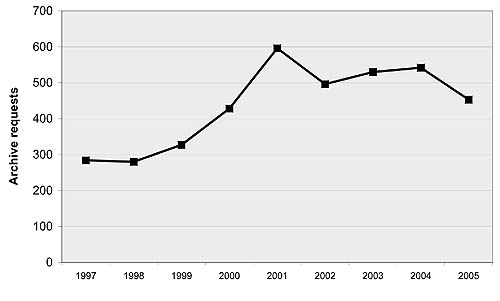 |
Figure 53. Number of ING archive requests per year
[ JPEG | TIFF
]. |














